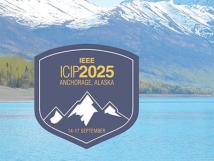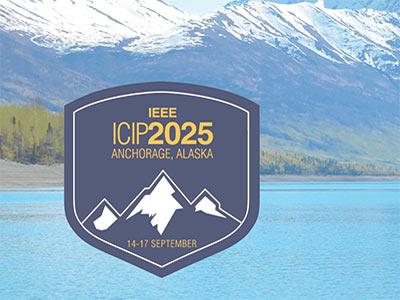
IEEE ICIP 2025 - The International Conference on Image Processing (ICIP), sponsored by the IEEE Signal Processing Society, is the premier forum for the presentation of technological advances and research results in the fields of theoretical, experimental, and applied image and video processing. ICIP has been held annually since 1994, brings together leading engineers and scientists in image and video processing from around the world. Visit the website.

- Read more about Shuffle Patchmix Augmentation with Confidence-Margin Weighted Pseudo-Labels for Enhanced Source-Free Domain Adaptation Poster
- Log in to post comments
This work investigates Source-Free Domain Adaptation (SFDA), where a model adapts to a target domain without access to source data. A new augmentation technique, Shuffle PatchMix (SPM), and a novel reweighting strategy are introduced to enhance performance. SPM shuffles and blends image patches to generate diverse and challenging augmentations, while the reweighting strategy prioritizes reliable pseudo-labels to mitigate label noise. These techniques are particularly effective on smaller datasets like PACS, where overfitting and pseudo-label noise pose greater risks.
- Categories:
 34 Views
34 Views
- Read more about The Art of AI: How a Multimodal Model Reveals the Secrets of Human Creativity in Paintings
- Log in to post comments
Assessing artistic creativity has long been a challenge. Traditional tests are widely used but often require time-consuming manual scoring. Thus, researchers are exploring a new way, such as machine learning, for automated artistic creativity assessment. Recent research on visual artistic creativity assessment has demonstrated that machine learning methods are effective but constrained by their reliance on visual data alone.
- Categories:
 45 Views
45 Views
- Read more about UTAL-GNN: Unsupervised Temporal Action Localization using Graph Neural Networks
- Log in to post comments
Fine-grained action localization in untrimmed sports videos presents a significant challenge due to rapid and subtle motion transitions over short durations. Existing supervised and weakly supervised solutions often rely on extensive annotated datasets and high-capacity models, making them computationally intensive and less adaptable to real-world scenarios. In this work, we introduce a lightweight and unsupervised skeleton-based action localization pipeline that leverages spatio-temporal graph neural representations.
- Categories:
 41 Views
41 Views
- Read more about Robust Estimation of Bump Height for Wafer-Level Packaging Using Opcital Triangulation
- Log in to post comments
Paper Abstraction:
- Categories:
 34 Views
34 Views
- Read more about GIVE: A Multi-Agent Framework for Generating Immersive Multi-Modal Virtual Environments for 3D Games - Supplementary Material
- Log in to post comments
In this work, we present a novel multi-agent framework for generating immersive 3D virtual environments from high-level semantic inputs, powered by large language and vision-language models (LLMs/VLMs). Unlike prior work that focuses primarily on visual output, data-intensive training pipelines, and code generation, our system coordinates a team of specialized agents, each assigned a role such as manager, planner, or expert in visual, audio, or spatial domains, to decompose and execute environment construction tasks within a game engine.
- Categories:
 72 Views
72 Views
- Read more about Texture- and Shape-based Adversarial Attacks for Overhead Image Vehicle Detection
- Log in to post comments
Detecting vehicles in aerial images is difficult due to complex backgrounds, small object sizes, shadows, and occlusions. Although recent deep learning advancements have improved object detection, these models remain susceptible to adversarial attacks (AAs), challenging their reliability. Traditional AA strategies often ignore practical implementation constraints. Our work proposes realistic and practical constraints on texture (lowering resolution, limiting modified areas, and color ranges) and analyzes the impact of shape modifications on attack performance.
- Categories:
 24 Views
24 Views
- Read more about INVESTIGATING ROBUSTNESS OF UNSUPERVISED STYLEGAN IMAGE RESTORATION
- Log in to post comments
Recently, generative priors have shown significant improvement for unsupervised image restoration. This study explores the incorporation of multiple loss functions that capture various perceptual and structural aspects of image quality. Our proposed method improves robustness across multiple tasks, including denoising, upsampling, inpainting, and deartifacting, by utilizing a comprehensive loss function based on Learned Perceptual Image Patch Similarity(LPIPS), Multi-Scale Structural Similarity Index Measure Loss(MS-SSIM), Consistency, Feature, and Gradient losses.
- Categories:
 46 Views
46 Views
- Read more about (Appendix) Rethinking the Backbone in Class Imbalanced Federated Source Free Domain Adaptation: The Utility of Vision Foundation Models
- Log in to post comments
Appendix of our paper: "Rethinking the Backbone in Class Imbalanced Federated Source Free Domain Adaptation: The Utility of Vision Foundation Models" accepted at IEEE ICIP 2025 workshop: Edge Intelligence: Smart, Efficient, and Scalable Solutions for IoT, Wearables, and Embedded Devices (SEEDS)
- Categories:
 100 Views
100 Views
- Read more about ICIP 2025 Supplementary
- Log in to post comments
This supplementary material accompanies our paper titled "Texturing Endoscopic 3D Stomach via Neural Radiance Field under Uneven Lighting."
- Categories:
 41 Views
41 Views
- Read more about (Appendix) MultiMAE Meets Earth Observation: Pre-training Multi-modal Multi-task Masked Autoencoders for Earth Observation Tasks
- Log in to post comments
MULTIMAE MEETS EARTH OBSERVATION: PRE-TRAINING MULTI-MODAL MULTI-TASK MASKED AUTOENCODERS FOR EARTH OBSERVATION TASKS (APPENDIX)
- Categories:
 33 Views
33 Views